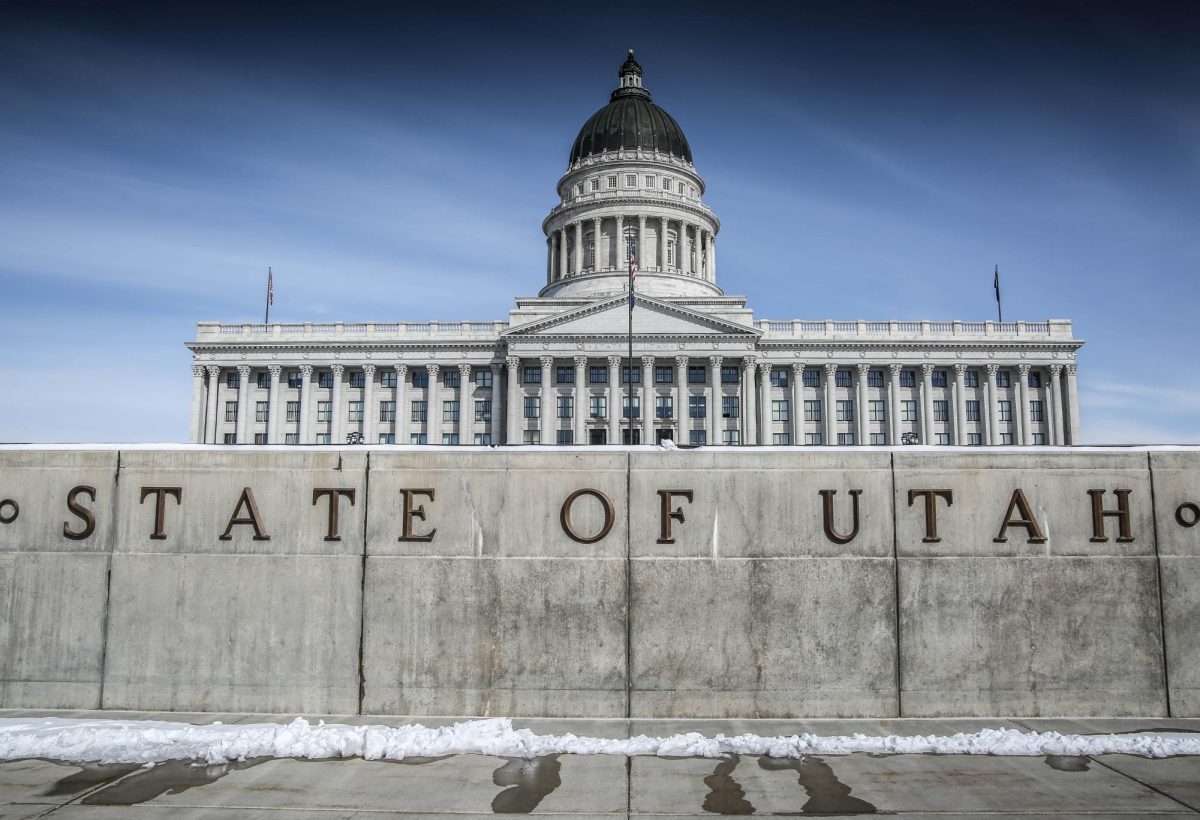Local Journalists on the Importance of Their Work
Salt Lake Tribune sign outside of Tribune’s news department in downtown Salt Lake City, Utah on Dec. 5, 2022. (Photo by Sarah Karr | The Daily Utah Chronicle)
February 10, 2023
Tim Vandenack, a reporter for the Standard-Examiner, began his tour of the Ogden-based newspaper’s office building not with the newsroom, but with a dimly lit storage room, cluttered with unorganized desks and chairs stacked on top of each other.
“This used to be filled with people,” he said. “We have an upstairs room about the same size, which was our newsroom, which is now just empty.”
The vacant spaces stood in sharp contrast with their current newsroom, a much smaller space with only a few desks for the remaining staff of the Standard. Vandenack is one of two reporters left at the Standard-Examiner, which is published daily and distributed to roughly 30,000 subscribers.
“I’ve been here about five years, and I think we had nine, 10 reporters, and that’s, you know, not even talking about editing side, photographers,” he said. “Nowadays, yeah, two of us, we have freelancers that we dabble into. I think our hope is to get another reporter.”
Vandenack has worked at the Standard since 2017 and said that the downsizing was due to various reasons, the largest of which being that the paper simply cannot afford to retain the same numbers of staff that it has previously.
“Newspapers aren’t profitable like they used to be,” he said.
He added that many publications, as well as advertisers, have opted to go online rather than remain in print, which takes away funding from papers like the Standard.
“Without the money, you can’t hire the staff,” he said.
The experience of the Standard is far from unique. Medill’s Local News Initiative, based out of Northwestern University, found that more than a quarter of the nation’s papers have been shut down since 2005. This number continues to grow, and is on track to be a third of the nation’s newspapers by 2025, as an average of two publications close weekly in the United States.
In addition, overall newspaper employment has dropped 70% since 2005, and over one-fifth of American citizens now live in a news desert, communities where residents have significantly lower access to local news and information.
The Importance of Local Journalism
Marcie Young Cancio, assistant professor of journalism and digital media at Salt Lake Community College, said she believes that journalism is an essential component of American society.
“I firmly believe that we are a democracy and we are able to be a democracy because of our press freedom,” she said. “I think that there’s a lot of things you can point to that can show the decay and decline of these democratic standards, and I think that free press — ethical, responsible, free press — is a really important part of keeping democracies safe [and] keeping democracies healthy.”
Young Cancio is also the founder and executive director of Amplify Utah, a nonprofit collaboration with the Salt Lake Tribune and SLCC founded in the summer of 2020. It intends to boost representative storytelling in journalism, assist student journalists in getting published and provide additional content for local publications.
“What I mean by representative storytelling are the stories that you don’t often see in local media for a wide variety of reasons, whether newsroom sizes have shrunk or just not having the resources to do the work,” Young Cancio said. “Stories that often have a diversity, equity and inclusion link to them, and things that just newsrooms often don’t have the resources to be able to cover.”
As a faculty advisor of SLCC’s newspaper, The Globe, Young Cancio said in its early stages, Amplify Utah tapped into the community college, the most diverse institute of higher education in the state, to look for the stories that are more representative of the Salt Lake’s communities.
Amplify Utah’s primary partner in this representative storytelling is the Salt Lake Tribune, and nearly 50 stories have been published in the newspaper through Amplify Utah since April 2021. Some examples of the diverse topics these stories have covered are Utah athletes competing in the Paralympic games, gender-inclusive restroom signs being implemented at the SLCC Taylorsville campus and Utah colleges working to conserve water on their campuses.
Though these pieces received publication through Amplify Utah, Young Cancio clarified that the organization does not actually generate any of the stories.
“We’re not creating any new content,” she said. “Amplify Utah is not a newsroom, they’re not a new news organization. It’s a collaborative project, meant to take what’s already happening out there, and bringing it all together in a place where these stories can be readily consumed.”
Through this collaboration, Young Cancio said Amplify Utah is able to support people with underrepresented viewpoints, student journalists and even local journalism itself.
“It’s meant to offer more content that is representative, more diverse content to local newsrooms, who may be struggling and may not have the content that they need, like the Standard-Examiner or any other news or local news organization,” Young Cancio said. “It’s also meant to help amplify these stories that are not often shared in mainstream media.”
She added the initial idea for the project was a nonprofit focused on media literacy, but that shifted when the opportunity arose to apply for funding from the Google News Initiative.
“I mean, while it’s not overtly a media literacy project, it is in the sense that we can’t really be media literate if we don’t know what’s happening in the world around us, that an understanding of the world around us can only come if we’re consuming stories and engaging with content,” she said.
This is precisely the reason Vandenack still believes local journalism is so important, despite the decline in the industry — he believes people cannot truly understand the community they live in without its coverage of smaller, local issues that national papers don’t pick up on.
“We’re smaller, we don’t have as many reporters — I think we’re still just as important as ever because you know, the stuff we cover, nobody else is gonna write about it,” he said.
For students, he added, this is especially important because it’s so easy to create a bubble around themselves on campus and not pay attention to what is happening in the surrounding community.
“People kind of just get in their own worlds and don’t really bother to look beyond them,” Vandenack said. “And I think, yeah, newspapers are a way to give people a glimpse of, ‘Hey, this is also going on in your community. You may not know it, but this is happening here.’”
Young Cancio agreed, and said oftentimes, local news is more important than national news when it comes to students’ day-to-day lives.
“It’s what happens in your everyday world, the things that your local newspaper — the Salt Lake Tribune, Deseret News, the Standard-Examiner — cover that play an instrumental role in your life,” she said. “When it comes to local news, you have to have it because if you don’t, then what is happening in your community, who is keeping your politicians honest, who is paying attention to how funds are being used?”
She added that without journalists paying attention to that and informing the public, then the opportunity for corruption to happen becomes much greater.
Because of this relevance, Young Cancio believes it is important for local journalism to persevere.
“I have to be an optimist — I firmly believe that free press and that good journalism is an important part of the fabric of our society,” she said.
She added this is only possible if journalism continues to evolve along with society. She explained that a lot of news organizations shut down because they died on the hill of what they thought journalism needed to be, contributing to the growing number of news deserts.
“I think one of the paths forward is industry professionals, emerging journalists, student journalists, looking for ways to protect journalism by adapting to the environment but still protecting what good journalism means,” Young Cancio said. “That comes with a lot of experimentation.”
As far as what students can do to support local journalism, Vandenack said, “By reading it, I suppose. By reacting. Like on social media for me, it’s always good when I see this story got x number of likes or got this number of comments and that lets me know, ‘Okay, that’s something people care about.’”
Young Cancio added students interested in journalism can also support it by doing the work themselves.
“Seek stories that help you understand the world around you a little bit more,” she said. “Amplify Utah is meant to be a place for all emerging and student journalists to be able to submit their work and have that potentially be published with local media, even though it started at Salt Lake Community College. Do the good work of trying to find those stories that you are not seeing within local media. Write those stories knowing that if you don’t do it, maybe this is a story that won’t get any coverage.”













